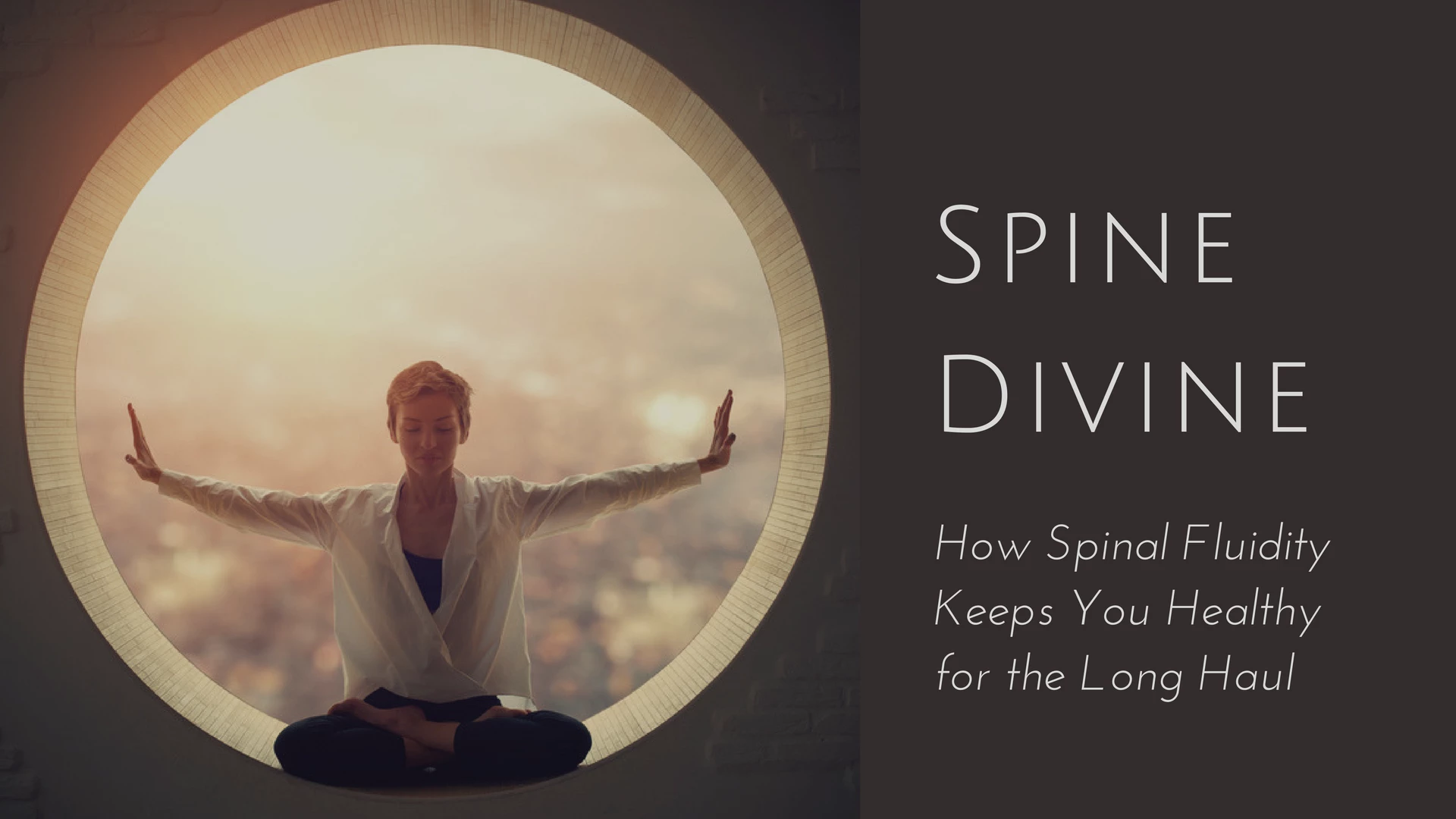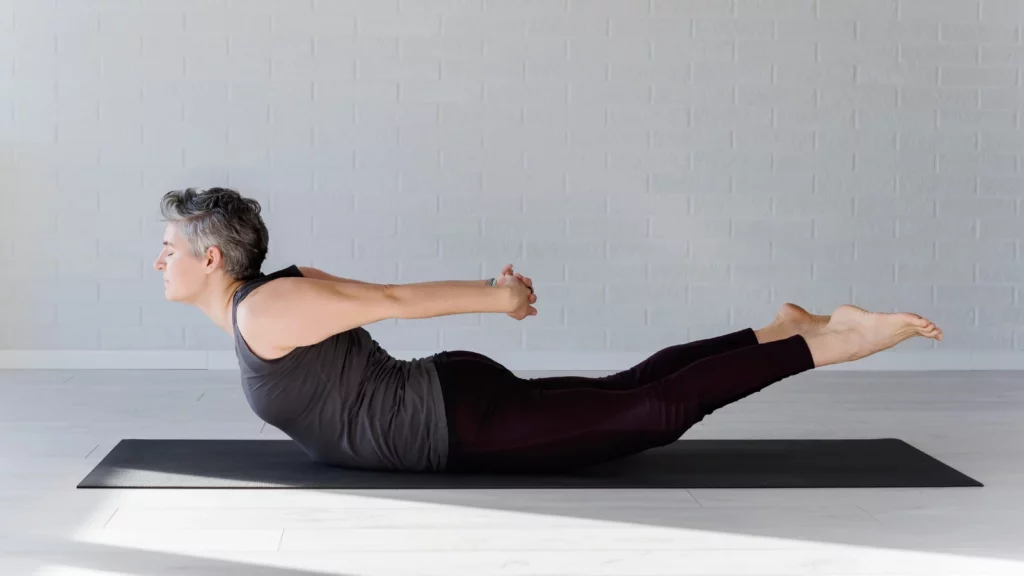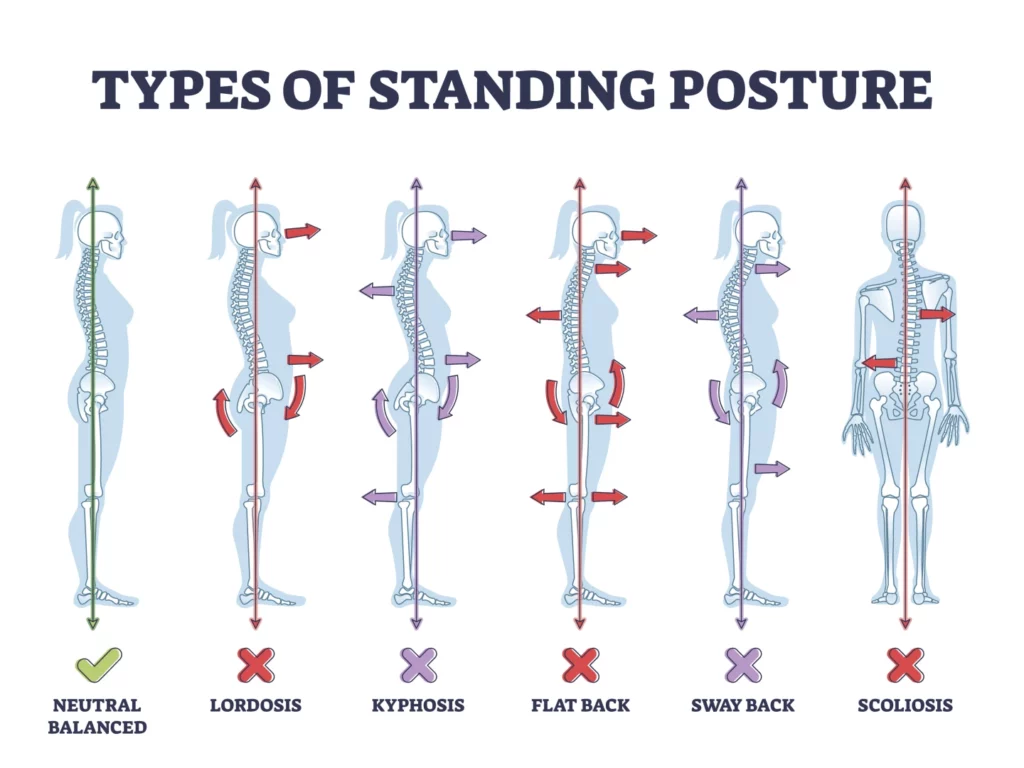Spine Divine – How Spinal Fluidity Keeps You Healthy for the Long Haul

Article At A Glance
In this interview with YogaUOnline, yoga teacher, Hellerwork Practitioner, Structural Integrator, and author Anita Boser invites us to consider how breaking out of chronic patterns can keep our spines youthful and pain-free at any age.
Do we get older just because of age? Or do the patterns we’ve etched into our bodies decrease the fluid movement in our spines and thereby limit our movement potential?
In this interview with YogaUOnline, yoga teacher, Hellerwork Practitioner, Structural Integrator, and author Anita Boser invites us to consider how breaking out of chronic patterns can keep our spines youthful and pain-free at any age. Incorporating non-linear, free movement–both on and off the yoga mat–bathes the intervertebral disks with cerebral spinal fluid, facilitates the free flow of nerve information through our bodies, and raises awareness of subtle movements to increase interoception. Oh, and it also feels great!
YogaUOnline: As a yoga teacher and Hellerwork Structural Integrator, you’ve stated that integration is central in your life. What is your background, and how has the idea of integration evolved for you?
Yoga and the Fluid Body
Anita Boser: As a child, I was very focused in my head on being smart. Starting as early as kindergarten, I think life teaches us to ignore our bodies. We go to school and want to run around and wiggle, but the teacher instructs us to sit still.
The older we get, the less variety we have in our movements; there is a greater tendency to get stuck in a rut. This is as true for me being a smart kid in school as it is being an adult who gets an office job, doing mental work sitting in front of a computer. Perhaps we can squeeze in three hours of exercise in a week, but the rest of the time is spent sitting in the same handful of positions all day. A lot of stillness is built into life, and that’s what my life was like. As a result, my body started hardening into those positions.
That is how connective tissue works; it starts to adapt itself to how we use the body. So if we’re moving in a repetitive way, it makes it easier to continue in a repetitive way. If we’re still, it makes it easier to stay still. If we move with a lot of variety, the body adapts to that variety, but unfortunately, most of us don’t. I certainly didn’t. If we spend a lot of time bent forward on our phones or our computers, the crouched pattern in our body starts to take hold; the longer we’re there, the more it takes hold. We might get up and walk, but it’s hard to completely straighten up because of the pattern that’s taken hold of us. That’s why yoga is so beautiful: very little of life is spent actually opening up, but opening the body is a major part of yoga.

YogaUOnline: In your work, you share this quote from Joseph Heller, “The process of life may be seen as one in which we start out ninety-nine percent water and end up virtually solid. In the course of aging, most of us find ourselves increasingly sedentary and confined, moving less and less. We may claim our static state results from pain, fatigue, or laziness, but which, in fact, comes first? To function properly, the body relies heavily on the movement of fluids. And as rigidity sets in, the fluid flow is impaired.” Do you think the fluid flow is the true fountain of youth?
Spinal Fluid: The Fountain of Youth
Anita Boser: Originally, I was going to call my book “Undulation: The Fountain of Youth” because it feels that way in my body. It seems like the more fluidly we move like kids, the younger we feel. Fluid movement is actually nourishing the tissues, so it’s not just something that feels good; it’s something that is good for the body. This fluid flow that Joseph Heller describes is so vital to nourishing our cartilage and nourishing our ligaments which don’t receive great blood flow as the muscles do. Moving is what they depend on to receive their nutrients and to take away the waste products.
YogaUOnline: How can increased fluidity in the spine improve overall spine health?
Anita Boser: I think when you unlock movement patterns, then you unleash more possibilities; you unleash the wisdom of being able to heal your own body. You also unleash the wisdom of self-awareness before you injure your body. I’m only in my head all the time. I’m a mile past where I’ve hurt myself by the time I have even an inkling that I’m getting near the edge of my limit.
YogaUOnline: Our attempts to release tension are often structured and conform to a pattern, creating its own kind of rigidity. Should fluidity come from a random movement that is purely intuitive?
Anita Boser: Fluidity is, in one sense, random, but it’s also coming from the body’s wisdom. If you learn, over time, to move more slowly or subtly, then you can feel inside your body. Your body will actually direct how to release itself. The wisdom is from inside, and it is random; it’s non-linear and non-repetitive, in general. Sometimes the body will be repetitive, but it knows how to get right into the perfect spot and which little movement is going to help it release.
YogaUOnline: How does this notion relate to the ideas of body awareness, exteroception, interoception, proprioception and how those might be affected or enhanced by bringing in subtle movement like this?
Anita Boser: As a society, we mostly pay attention to our body in relationship to the things around us via our nerve endings. That’s exteroception. Proprioception is being aware of where our body is in space and in relationship to itself. There are studies that have found that improved proprioception increases people’s threshold for pain. People who have better proprioception are less likely to have chronic pain. So improving our proprioception is one way to feel better in our bodies. If we have a balance with our nerve endings by telling our body where we are in space, there’s less tendency to feel something as painful.
YogaUOnline: So when we live in our head, we’re neglecting our body. You mentioned posture. How else does that disconnect between mind and body show up in everyday life?

Anita Boser: One way that body neglect shows up is in many people’s neck pain. This neglect stems from seeing the head and the body as different entities. Many people, including my past self, feel like the body is simply an organism for carrying the brain around. I have had a few clients say to me that that’s what the body is truly for. In actuality, a lot of who we are is in our body as well; there is a lot of experience available to our bodies. There is a lot of knowledge and wisdom that comes from the body, if we learn to pay attention to it. Learning to pay attention to slow and small-subtle movement helps us gain wisdom that we would never otherwise know about if we were living just in our brains.
Yogic Wisdom: Undulation and a Healthy Spine
YogaUOnline: Can you elaborate on that slow and subtle movement you mentioned? Is that the same as undulation or are those different things?
Anita Boser: Undulation is a broad concept of fluid movement through the body: it’s a non-repetitive, non-linear movement. Undulations can be big. We can have really big flowing motions, and we can also have tiny or subtle undulations like with the breath. Being aware of that and being able to manipulate it and work with it makes us much more fluid; undulation encompasses all.
YogaUOnline: That brings to mind the quote, “The body is as young as the spine is flexible.” Is this congruent with your work?
Anita Boser: I love that saying. Imagine when you were four years old; you could do anything you wanted. You didn’t complain, you had a good time, and your spine was very flexible; you didn’t have stiffness or rigidity. You were very fluid and supple.
Then, we get older. Do we get older just because of age? Or do we get older because of that rigidity we build into our lives? As adults, we hold still, adopt certain postures and avoid other postures because it would be weird or childish even. But now, here we are, older, and I want to be a bit more childish. I want that childish fluidity in my body.
YogaUOnline: Can we try this with an example? As you mentioned, many people have repetitive movement patterns from sitting at their computers all day. What would you suggest they try?

Anita Boser: Absolutely. Many people at desks spend a lot of time with their arms in front, so if you can do this without putting pain in your shoulders, I would first suggest bringing your hands behind your head and then leaning from side to side. Then, start feeling your spine; find where this feels good. You might also feel that it’s a little sticky. If you start paying attention to what your body wants, you can add all the little variations that will help you on your way to a healthy spine.
YogaUOnline: What is the potential for someone who hasn’t moved for a long time and is very set in their ways? Is there potential to regain a lot of fluid for a healthy spine?
Anita Boser: If someone is set in their sedentary ways, there is potential for getting fluid back if they can move into it in a gradual way. One of the ways that isn’t very effective is deciding to train for a marathon. Although that has its benefits in terms of motivation for people, in terms of fluidity, it really helps to be able to scale activities. Gradual means being able to work at your edge, wherever that may be.
Small, fluid movements really help a lot of people. That’s why I think undulation has been so effective for people with fibromyalgia because it hurts to move. However, if they can move just a little bit to start, then the next thing they know, they can move a little more without it hurting. If they continue to work gradually, they can build more fluidity without it hurting. This is true whether it’s someone with fibromyalgia or someone who’s been sitting on the couch for decades like I did. That is how I started, and I’m in better shape now than I have ever been. I credit undulation with starting me on the journey.
YogaUOnline: Part of your journey has resulted in you becoming a yoga teacher. Can you share a little bit about the relationship between, and the potential benefits of, undulation and yoga?
Anita Boser: Samskara is a Sanskrit term that refers to grooves of experience. Our neurology develops by learning to move in a certain way, and we tend to repeat it because that’s what works. For example, when you’re learning to drive a car, you don’t want to have to think about it all the time. If you’re learning to walk, you don’t want to have to think consciously about every motion. The brain remembers and repeats the pattern that enabled us to walk or drive a car the last time. The good news is you don’t have to think about it every time to be able to do something; the bad news is you tend to get stuck in a rut. Over time, the rut wears out some body parts and leaves others underused. A great opportunity to change that is yoga. In yoga, we do our backbends that we don’t do anywhere else. We twist in great ways that we wouldn’t do otherwise.
Yoga is phenomenal for getting us out of the rut, but even in yoga, we can get into our yoga ruts. If I go into Warrior I without paying attention, I’ll go into it the same way I always go into it. If I go into Bridge without awareness, I’ll flex my spine the way I typically do it. A good yoga teacher will help us get out of those ruts, but undulation takes it a step further. If you take those poses and add undulations to them, you can really expand the experience of how far out of the rut you can get.
Youthful Spine, Youthful Body
YogaUOnline: You have a course on YogaUOnline on this topic called “Youthful Spine, Youthful Body: The Role of Fluidity in Healthy Aging.” Tell us a little bit more about that class and who should take it.
Anita Boser: The course begins by explaining why fluid movement is important – What benefits it gives us in life and how we can build more fluidity in our daily lives without a tremendous effort. We’ll also discuss how we can be aware of more subtle movements and how we can develop interoception. Then I will share the five keys to fluid movement, the five ways to change any movement – yoga or otherwise- to make it more fluid for a healthier spine.
I believe anyone could benefit from this course, but particularly someone who feels stiff somewhere in their body, especially in the spine, because we are going to focus on a healthy spine. Yoga teachers will also benefit from this course because they will gain many specific ideas for things they can bring to their students.
YogaUOnline: Thank you very much, Anita.



